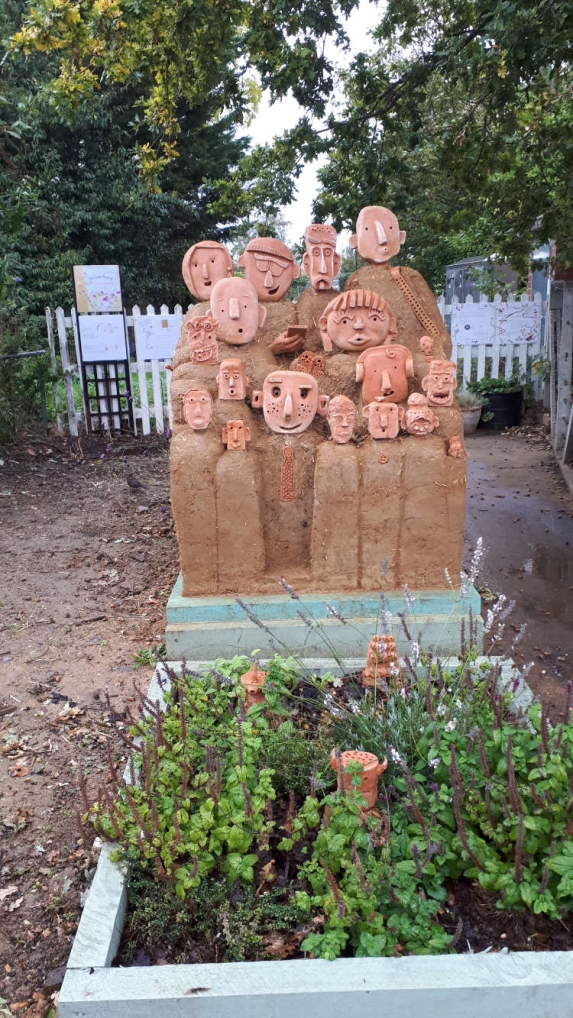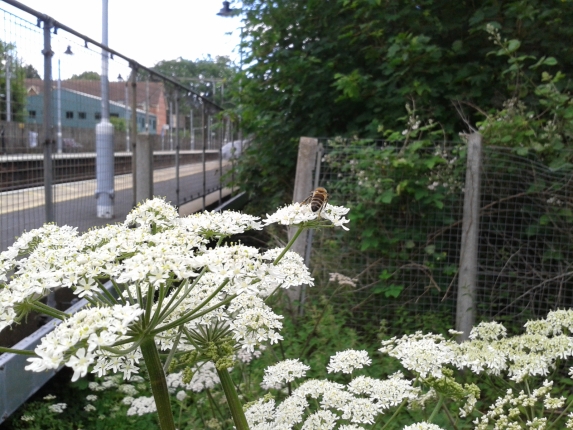Published on: Tuesday, 5 October 2021
Last updated: Tuesday, 5 October 2021

Above: The Bee Friendly sculpture at Alresford station Credit: Essex and South Suffolk Community Rail Partnership
Rail station platforms in Essex are helping to support fragile bee populations thanks to a partnership between the Bee Friendly Trust and the Essex and South Suffolk Community Rail Partnership.
The Bee Friendly Trust has so far installed 50 projects, including wildlife friendly sculptures and planters, across the country – with a quarter of these on the Greater Anglia network.
The Essex and South Suffolk Community Rail Partnership has worked with the Trust on projects at Alresford, Althorne, Bures, Clacton-on-Sea, Colchester, Great Bentley, Kirby Cross, Mistley, South Woodham Ferrers and Witham.
At Alresford, volunteers, children from Alresford Primary School and the Cobnuts Co-operative, came together with the Essex and South Suffolk Community Rail Partnership, the Bee Friendly Trust, the Community Rail Network and Greater Anglia to install a unique sculpture that doubles as a home for wildlife in the station’s wildlife garden, which won a ‘Bees’ Needs Champions’ Award from the government’s Department for Food and Rural Affairs (DEFRA).
At Colchester, Great Bentley, Sudbury, Witham, South Woodham Ferrers and Althorne, wooden planters filled with a variety of herbs have been installed on the stations’ platforms and two large wildflower planters will provide a haven for pollinating insects at Bures.
Once the herb gardens have become established people will be able to help themselves to fresh herbs or enjoy their scent as they wait for trains.
Elsewhere on the Greater Anglia network, planters have also been installed by the Bee Friendly Trust at Cambridge and Sudbury.
Dr Luke Dixon, co-founder of the Bee Friendly Trust, said, “Honey bees can fly up to three miles from the hive when out foraging for pollen and nectar, but in areas that are densely populated or over-farmed they sometimes struggle to find enough food.
“That’s why we’re working with railway authorities, community rail partnerships, and local groups across the UK to install bee-friendly flowering planters, fruit tree orchards and micro wildlife gardens on railway station platforms.”
Greater Anglia’s Customer and Community Engagement Manager, Alan Neville, said, “The herb gardens and wildflower planters are a wonderful addition to these stations and will help to make them more attractive and welcome to passengers and provide a boost for wildlife too. We’re very grateful to everyone involved in helping to make these stations more sustainable and welcoming.”
“This is all helping the railway in East Anglia to lead the green recovery from the pandemic by being a much greener way to travel - and our new fleet of trains will contribute even more thanks to their more environmentally friendly features which reduce CO2 and particulate emissions in the region further still and offer a convenient, comfortable alternative to the car.”
Rail stations in East Anglia are increasingly becoming havens for local wildlife thanks to the efforts of volunteers who have transformed land the equivalent of five Olympic-sized swimming pools into thriving wildlife gardens.
Greater Anglia’s team of station adopters – who help to look after their rail stations for the benefit of their communities – increased the total area of station garden across the network by 14% last year and devoted much of it to creating wildlife friendly areas.The gardens, some of which have been developed over many years, are becoming havens for local wildlife populations – with the railway increasingly being recognised by ecologists as a ‘green corridor’ which provides a sanctuary for many different kinds of flora and fauna.
In a recent survey, Greater Anglia station adopters reported a wide range of creatures visiting their stations including many different types of butterflies as well as bees, slow worms, bats, foxes, deer and many varieties of birds, recording more than 200 different species.
Greater Anglia has joined the rest of the rail industry in pledging to make stations across Britain more sustainable.
Action to reduce waste, support local wildlife and cut the carbon footprint of railway stations will be informed by the industry’s new Sustainable Stations: Best Practice Guide, which details ways in which train operators can meet this commitment in support of global goals of decarbonisation, reducing waste and supporting local plant and animal life.

Above: A bee on flowers at Ingatestone station Credit: Greater Anglia


